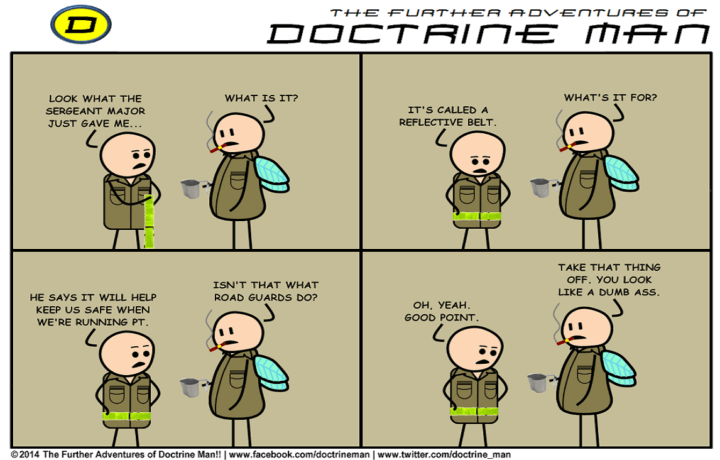“I felt a great disturbance in the Force, as if millions of voices suddenly cried out in terror and were suddenly silenced.”
– Obi-Wan Kenobi, Star Wars: A New Hope
With a single swipe of a digital signature, Secretary of the Army Mark Esper may have helped to bring an end to the reign of one of the most ubiquitous pieces of equipment in the Army inventory: the reflective belt. In a January 4 memorandum – part of an ongoing series of directives issued since April 2018 in an effort to “improve warfighting readiness and lethality” – Secretary Esper amended Army safety program policy, stating the service “does not require the wear of the reflective training belt or vest during daylight hours, or while conducting physical training on closed roads or dedicated physical training routes.” Be still my beating heart.
Known as everything from the Belt of Obedience to the Belt of Invincibility, the reflective belt found its footing in the post-Cold War era and quickly evolved to become a symbol of derision across the Army. At the same time, it morphed from a humble “glow belt” into a military cultural icon, thanks in no small measure to an overly-zealous Army safety program. After replacing the old reflective vest – which served a purpose at a time when road guards protected hapless formations during morning physical training – the yellow reflective belt quickly became a mandatory uniform item, worn inside and out, rain or shine, in daylight or darkness. It was more than a PT uniform accessory: it could soon be found on trainees venturing to the Post Exchange, soldiers wandering forward operating bases at night in combat zones, and spouses out for a morning walk to Starbucks. As time wore on, some leaders adopted rank-specific color codes for reflective belts while still others had their names and rank insignia embroidered on them. More recently, the “lifestyle retail company” Urban Outfitters offered the reflective belt for sale for $30; sadly, stocks of the item were quickly depleted, and the item now lists as “sold out.” If that’s not an icon, I don’t know what is.
However, the reflective belt represented much more than safety. It was a symbol of a culture of risk aversion that ebbed into our ranks as the force drew down in the wake of the end of the Cold War. Even as we cried the virtues of mission command and the necessity of trust, we signaled to leaders (and soldiers) of all ranks that they couldn’t be trusted with their own safety. When the former commanding general of Forces Command – the Army’s largest operational organization – recognizes that we’ve “lost our collective minds” with respect to our reverence of the reflective belt, we have a problem. That it required the Secretary of the Army to step in is more than a little embarrassing, but also more than a little welcome.
But don’t be too quick to pen the epitaph for the reflective belt. Die-hard adherents to the mystic powers of the humble glow belt will not be so easily dissuaded. Even an updated safety program policy will retain enough loopholes that entrepreneurial leaders of all ranks will find inventive ways to ensure the reflective belt lives to fight another day. We didn’t get here overnight, and we won’t rein in common sense any time soon.
The reflective belt is dead. Long live the reflective belt.



